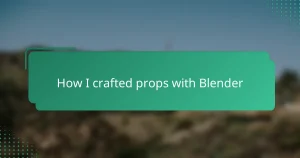Key takeaways
- Sci-fi props are essential storytelling tools that enhance the immersion of futuristic narratives.
- Mastering tools like the Polygon Pen, Extrude, and Bevel in Cinema 4D is critical for creating complex and functional designs.
- Texturing and lighting are vital for adding personality and realism to sci-fi props, with careful adjustments making a significant impact.
- Patience in the rendering phase and organizing projects into manageable parts can elevate the quality of your work.

Introduction to Sci-Fi Props
Sci-fi props have always fascinated me with their ability to spark imagination and transport viewers to otherworldly realms. They are not just objects; they are storytelling tools that shape the very atmosphere of a futuristic narrative. Have you ever noticed how a single gadget or weapon in a sci-fi film instantly makes the world feel more authentic and immersive?

Essential Tools in Cinema 4D
When I first opened Cinema 4D, the array of tools felt overwhelming, but I quickly realized that mastering a few essentials made all the difference. The Polygon Pen became my go-to for creating and refining the intricate shapes that give sci-fi props their complexity. Have you ever noticed how a perfectly crafted edge can turn a simple shape into something that looks genuinely high-tech?
The Extrude and Bevel tools were game changers for me. They allowed me to add depth and detail without overcomplicating the mesh, which is crucial when designing props that need to look both futuristic and functional. I remember spending hours tweaking these to get just the right balance between sharpness and smoothness, which really brought the designs to life.
Another tool I can’t stress enough is the Material Editor. Texturing is where sci-fi props gain their personality—whether it’s a sleek metallic finish or worn, battle-scarred surfaces. Playing around with different shaders and textures often felt like painting my own sci-fi story, and that hands-on approach made the whole rendering process incredibly satisfying.

Basic Modeling Techniques for Props
When I started modeling sci-fi props, I quickly learned that blocking out shapes using basic primitives like cubes and cylinders laid the foundation for everything. It’s amazing how just manipulating these simple forms can give birth to complex, futuristic objects. Have you ever tried adjusting a cylinder’s segments and suddenly seeing it transform into a sleek laser barrel? That moment hooked me every time.
Working with subdivision surfaces was a game changer too. By smoothing out the hard edges without losing the original shape, I could create those smooth, aerodynamic forms that scream sci-fi. At first, it felt tricky to balance detail with simplicity, but once I tweaked the mesh just right, the model started to feel alive and believable.
One technique I often rely on is using the Knife tool to add precise cuts and details. It’s like carving into the model, and those fine edges or panel lines instantly elevate a prop from generic to realistic. When I carefully slice and shape, I almost feel like a craftsman, giving life to objects that could belong in a spacecraft or a high-tech battlefield.

Texturing and Materials Workflow
Texturing in Cinema 4D became my favorite part because it’s where the prop truly starts to tell its story. I often found myself experimenting with layered shaders—combining metallic finishes with subtle scratches—to give each piece that lived-in feel. Have you noticed how adding just a hint of wear can transform a shiny robot arm from sterile to believable?
Choosing materials was like selecting colors for a painting. I remember struggling to get the right balance between glossiness and roughness; too much shine, and the prop looked fake, too little, and it lost that sci-fi edge. Using the Material Editor’s preview helped me tweak these settings in real time, making the process more intuitive than I expected.
One trick I swear by is incorporating procedural textures for added complexity without extra polygons. By using noise or grunge maps, I could create subtle panel lines or surface imperfections that felt organic. It’s amazing how small details in textures can elevate a flat prop into something that feels part of a living, breathing world.

Lighting and Rendering Settings
Lighting in Cinema 4D was one of those areas where I had to learn by trial and error. Setting up a mix of area lights and spotlights helped me sculpt the form of my sci-fi props, emphasizing their sharp edges and futuristic contours. Have you ever played with light intensity until shadows revealed just the right amount of detail? That moment when the mood clicks is incredibly satisfying.
When it came to rendering, choosing the right settings was crucial to avoid flatness or noise. I found that enabling global illumination and ambient occlusion added depth and realism without costing me endless render time. Balancing render quality with efficiency felt like walking a tightrope, but with practice, those subtle lighting effects made my props jump off the screen.
One thing I still remember vividly is tweaking the reflection settings on metallic surfaces. It was fascinating how adjusting the Fresnel effect influenced how light bounced, giving me that authentic sci-fi gleam. Do you notice how reflections can instantly convince you an object belongs in a high-tech universe? That little detail made all the difference for me.

Step-by-Step Prop Creation Process
The first step I take in creating a sci-fi prop is blocking out the basic shapes using primitives like cubes and cylinders. It might sound simple, but this stage feels like laying the groundwork of a building—if the foundation isn’t solid, the whole prop feels off. Have you ever noticed how just stretching or beveling these simple forms can suddenly start to resemble a gadget from a spaceship?
Next, I dive into adding details with tools like the Knife and Extrude. This part is where I get excited because it’s like revealing the prop’s personality—those panel lines, vents, or ridges give it depth and realism. I often find myself tweaking and slicing for hours, driven by that urge to make the design feel both functional and visually striking.
Finally, refining the model with subdivision surfaces allows me to smooth hard edges while keeping the sci-fi vibe intact. It took me a while to get comfortable balancing smoothness and detail, but once I did, the props truly began to come alive on screen. Do you know that satisfying feeling when something you modeled looks plausible enough to exist in a futuristic world? That’s what keeps me hooked every time.

Tips and Tricks from My Experience
One tip I can’t stress enough is to embrace patience during the rendering phase. Early on, I used to rush through settings, only to find my sci-fi props looking flat or lifeless. But slowing down, testing different light setups, and tweaking materials patiently transformed my renders from okay to extraordinary. Have you ever noticed how just a small shift in lighting can change the entire mood of a scene? I’ve been there, and it’s worth every minute spent.
Another trick that changed my workflow is leveraging layers and instances within Cinema 4D. It might sound technical, but organizing complex props into manageable chunks saved me countless headaches. Breaking down a complicated model into smaller parts not only speeds up rendering but also lets me focus on perfecting each detail. Do you struggle with managing big projects? Trust me, this approach makes things feel less overwhelming.
Finally, don’t underestimate the power of custom brushes and alpha maps when texturing. I once added a subtle dirt map over a pristine metallic surface and suddenly, the prop told a story—wear and tear that made it believable. It’s like giving your creation a history, a life beyond just being a shiny object on screen. Have you tried adding those little imperfections? They might just be the secret ingredient your props need.


